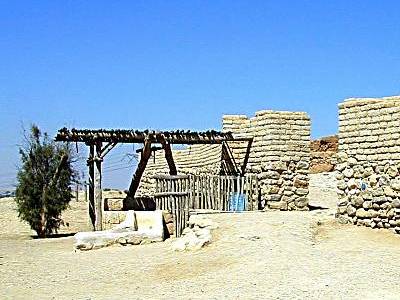Mapping the Bible
Negev
The desert that separates Egypt from Canaan, or modern-day Israel. Abraham and Sarah travel through the Negev to Egypt when there is a famine in Canaan. This is also where Hagar has her famous encounter with God at the well.
The Ladder of Tyre
Also known as Rosh HaNikra, or the “head of the grottos.” This chalk cliff with naturally occurring steps is the traditional entrance of Abraham to the promised land.
Canaan
The Promised Land. In Biblical times Canaan included modern-day Israel, Lebanon, and parts of Jordan, Syria and northeastern Egypt. Canaan is thought to be one of the oldest continually inhabited locations in the world.
Gerar
Canaanite city, where Abraham tries to pass off Sarah as his sister to King Abimelech in order to save his own life—a repeat of his behavior in Egypt.Photo from Bibleplaces.com
Memphis, Egypt
Abraham and Sarah flee to Egypt when there’s famine in the promised land. Hagar’s native land. Probable home of the Pharaoh during Abraham and Sarah’s lifetime. According to tradition, Hagar was Pharaoh's daughter.
The Great Ziggurat of Ur
Temple of the ancient Mesopotamian moon god, Nanna, built around 2100 BCE and partially restored by Saddam Hussein. The site of an American army base and an important symbol of the pagan religion that dominated the land of Abraham and Sarah’s birth.
Shechem
The first place Abraham and Sarah stopped when they entered the promised land of Canaan. At Shechem, God reiterated His covenant to Abraham. In return, Abraham "built an altar to the Lord who had appeared to him...and had given that land to his descendants" (Gen 12:6-7).
Nasiriyah (Ur)
The site of the ancient city of Ur, the traditional birthplace of Abraham and Sarah.
An important early battle in the 2003 invasion of Iraq occurred here.
Mecca
The holiest city in Islam. In the Muslim version of this story, Abraham leads Hagar to Mecca and leaves her there to help spread the word of God. Here, she discovers a spring and digs a well, the Zam-Zam, with her own hands.
Haran
This is where Abraham received the call from God to leave Mesopotamia and go to the promised land. This was an important trading center. Like Ur, it was devoted to the worship of the moon god, Nanna, also known as Sin.
Bethel
In ancient times, this site was an important settlement on “The Patriarch’s Highway,” or the north--south road. The name means House (Beth) of God (El). The site of Abraham and Sarah’s second settlement in Canaan.
Hebron
Frequent dwelling place of Abraham and Sarah. Traditional site of The Tomb of the Patriarchs and Matriarchs. Today this city is controlled by the Palestinian Authority.
The Machpelah
The cave where Abraham, Sarah, Isaac, Rebecca, Jacob, and Leah are reputed to be buried. The site of Abraham's original purchase of Canaanite land.
Sodom and Gomarrah were probably located on the eastern coast of Dead Sea in modern day Jordan.
Sodom and Gomorrah
The cities that God destroys because of the inhabitants’ sins. Abraham argues on their behalf, begging God not to annihilate the cities if He can find 10 good men. (Gen. 19:19-20)
Sodom and Gomarrah were probably located on the eastern coast of Dead Sea in modern day Jordan.
Mount Moriah
Traditionally thought to be the temple mount in Jerusalem, the site of Abraham’s sacrifice of Isaac.
Photo of the well from Bibleplaces.com.
Beersheba
A city in the Negev where Abraham settles after he follows God's commandment to sacrifice his son on Mount Moriah.
The wilderness of Beersheba In the bibical story, Hagar and Ishmael wander here after Abraham exiles them from the campsite (Gen, 21:14-20).







